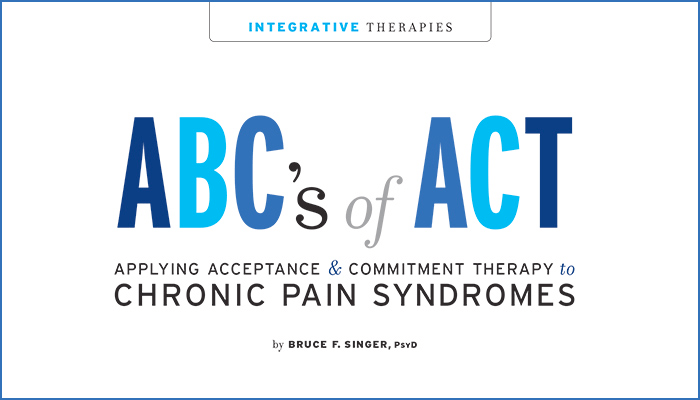Acceptance and Commitment Therapy

In 1994, the International Association for the Study of Pain pain as “an unpleasant sensory and emotional experience associated with actual or potential tissue damage or described in terms of such damage,” and this has become the accepted of pain.1 As a psychologist, my attention to this has always been drawn to the phrases “emotional experience” and “potential tissue damage,” as these speak to the underlying cognitive perceptions that magnify actual physical pain.
Many people living with chronic pain have suffered spiritually and emotionally, which can increase pain catastrophizing and magnification. They have a chronic pain syndrome, which is a biopsychosocial phenomenon that impacts up to 25 percent of all individuals experiencing chronic pain.2
Chronic pain syndromes typically do not respond to standard pain management treatments, in part because those treatments focus on physical symptomatology while neglecting underlying cognitive and emotional issues that sustain pain and suffering. In 1999, Eccelston and Crombez defined chronic pain as an “inescapable fact of life: Pain will emerge over other demands for attention. … Chronic pain can usefully be defined as chronic interruption by pain.”3 This interruption is to quality of life. How then do we as clinicians help our patients find their paths again?
PSYCHOLOGICIAL FLEXIBILITY
Recent research has begun to focus on an emerging theoretical model of contextual cognitive behavioral therapy (CCBT) that appears to improve outcomes in the psychosocial treatment of pain syndromes: psychological flexibility. In the words of Burhman, Skogland et al., “It refers to the person’s ability to consider all the options of persisting or changing behavior to pursue ones’ goals even in the presence of interfering private experience. …”4
Psychological flexibility is at the heart of acceptance and commitment therapy (ACT), which is the work of Steven C. Hayes, PhD, and his colleagues at the University of Nevada.5 Formulated in the 1980s, ACT is rooted in relational frame theory (RFT), a comprehensive theory of language and cognition that is, in turn, an offshoot of behavioral analysis. Borrowing elements of CBT and the mindfulness work of Jon Kabat-Zinn and his colleagues at the UMASS Medical Center in the late 1970s, ACT integrates experience, metaphors, acceptance, behavioral change processes and even the inherent qualities of the clinician in facilitating greater psychological flexibility in the client.6
ACT has been shown to be effective in a) increasing physical and social functioning, b) reducing high medical utilization, c) relapse prevention, d) mood self-regulation and e) increasing self-efficacy in pain management. The American Psychological Associ-ation’s Division 12 (Clinical Psychology) designates ACT as an evidence-based efficacious treatment for chronic pain with strong research support.7
A = ACCEPTANCE
The “A” of the ABC’s of ACT is acceptance or willingness, as it is often called, and it may be understood as the “conscious embrace of psychological experiences when to otherwise attempt to avoid them negatively impacts on overall functioning.”8 By utilizing the word willingness as synonymous with acceptance, ACT teases out the behavioral component so essential for change. Willingness is inherently active, a leap forward in behavioral activation, and a skill that can be learned to counter maladaptive habits of psychological rigidity and avoidance. As with mindfulness, acceptance is frequently taught through the practice of present-focused meditation.
B = BELIEF
The “B” of the ABC’s of ACT refers to our beliefs and our habitual attachment to self-defeating thoughts. In the language of ACT, individuals are too often fused to certain thoughts and beliefs that take on an automatic and unquestioned or habitual quality. I often hear individuals with chronic pain tell me that “My back [or head or leg] is killing me.” This kind of catastrophizing language may present as a figure of speech, but it is one that—when repeated often enough—becomes an unquestioned “truth” that contributes to a sense of helplessness in the face of pain. The qualities of cognitive fusion include black or white thinking, judgmental and self-critical language, and a “stuck-ness” about either the “woulda-shoulda-coulda’s” of the past or the “what ifs” of the future.
The ACT therapist seeks to engage the acceptance and willingness muscles through the process of cognitive defusion. This process involves stepping back from habitual thoughts, feelings and behaviors to learn how to respond to these not as truths but in terms of their workability. When contextualizing thoughts and feelings, the defusion process loosens the need to control thoughts (or feelings or behaviors) and creates a broader perspective that opens one up to the willingness to take valued action.
Think of those old Sergio Leone “Spaghetti Westerns” that starred a young Clint Eastwood as the man with no name. Inevitably, they built to a climax in which Eastwood’s character had to face down a group of black-hat-wearing villains. The camera held each face in an extreme close-up that was so intense on a Cinemascope screen that the slightest twitch of an eye was operatic in its meaning. And then, when the gunfire ended—with Eastwood the sole survivor—the camera craned up high in the sky as his character rode off on his horse: a tiny figure in a vast landscape. The shift from extreme close-up (with its blinders) to a high crane shot (with its broad perspective) reflects the defusion process as an individual moves from psychological rigidity to psychological flexibility.
ACT encourages creative interventions to facilitate defusion and asks us to look at the relationship we have with our thoughts. Let us return to the phrase “My back is killing me.” While there is no evidence to support this statement for virtually everyone I have worked with, it continues, through habit, to be repeated. But what if we consciously repeated it very quickly over a very short time span? Masuda, Hayes, Sackett and Twohig found that rapidly repeating self-relevant negative thoughts out loud (a defusion exercise) reduced associated distress more than comparison interventions like distraction or thought control.
You might try to take 30 seconds and repeat the “killing me” phrase (or another similar one of your choice) as quickly as possible. If the jumble of sounds that results brings a smile to your face then you are engaging in a defusion process that can open the door to psychological flexibility.
C = COMMITMENT
Once we have embraced acceptance, where does willingness take us? The “C” of the ABC’s stands for “Commitment,” and this is an essential aspect of the ACT focus on behavioral activation. Individuals are asked to identify their personal and essential values and then commit to them through behavioral change. Values are neither ethics or morals nor goals; they are a set of ideals or standards particular to each individual. One might want to be a good mother, which is a goal, but the ACT practitioner would want to explore with a client what being a good mother means. If it means that the individual sees herself as a caring and loving person, then she is utilizing the language of values. The client may or may not ever be a mother, but she can always be a caring person.
What Do You Want Your Life to STAND FOR?
One ACT intervention to help individuals identify their values is called “What Do You Want Your Life to Stand For?” In this intervention, the individual is asked to imagine their funeral and who might get up to speak in eulogy. What would the individual want his or her family members or friends to say about them? In speaking through the voices of their loved ones, the individual engages in a creative intervention to verbalize his or her own unique set of values.
Commitments and the goals that come out of them must be specific and measurable, practical and able to be accomplished. Goals should be approachable and not avoidance based. They should include an understanding of what one has lost but also a vision for the life one wants to inhabit.
The MOVIE QUESTION
To help patients rediscover their values and commit to the pursuit of more purposeful and meaningful functioning, I devised an ACT intervention I call “The Movie Question.” In this intervention the therapist asks: “If I were to see the movie of your life in six months or a year, what would it look like?”
This question seeks specific “scenes” from a person’s imagined future, not simply abstractions. If they say, for example, “I want to be happy,” I might press them to describe scenes that would demonstrate “happiness.” They might then describe cooking breakfast for the children or taking a walk through the autumn woods with their partner. The point is to help them envision changes in behavior that can bring greater purpose and that are practical and achievable.
Having established and positively reinforced their “scenes,” I then ask them what kind of movie this would be: a documentary, triumph of the human spirit, or perhaps a comedy or drama. Once they have identified the genre, I ask one more question: “What would your movie be called?” Giving it a title formalizes the intervention for them, and again, no matter what the answer, the therapist provides positive reinforcement for the individual’s choice.
In sum, ACT asks us to 1) Accept our reactions and be present, 2) Choose a valued direction, and 3) Take action. I have seen my own practice deepen through the use of ACT language, metaphors and interventions. The ACT toolbag is bottomless, which makes it an invaluable and accessible tool for helping individuals develop greater self-efficacy in the management of pain and co-occurring disorders. {PP}
BRUCE F. SINGER currently sits on the Medical Advisory Board to the U.S. Pain Foundation and the Education Committee of the American Academy of Pain Management. He is Chief of Psychology for Crossroads Centre, Antigua. He is authoring a book on mindfulness approaches to managing chronic pain entitled Find Your Black Ducks, and his guided meditations and a new album of meditative music, Heartful: Music for Julie, can be found through his website, www.brucefsinger.com.
CITATIONS
1 >> International Association for the Study of Pain, 1994.
2 >> U.S. Department of Veterans Affairs, May 25, 2010. www.va.gov/PAINMANAGEMENT/Chronic_Pain_Primer.asp
3 >> Eccelston, C., & Crombez, G. (1999). Pain demands attention: a cognitive-affective model of the interruptive function of pain. Psychological Bulletin, 125(3), pp. 356-366. 4 >> Buhrman, M, Skoglund, A., Husell, J., Bergtrom, K, et al (2013). Guided internet-delivered acceptance and commitment therapy for chronic pain patients: A randomized controlled trial. Behavioral Research and Therapy, 51, 307-315.
5 >> Hayes, S., Strosahl, K.D., & Wilson, K.G. (2012). Acceptance and Commitment Therapy, Second Edition: The Process and Practice of Mindful Change. New York: Guilford Press.
6 >> Luoma, J.B., Hayes, S.C., and Walser, R.D. (2007). Learning ACT: An Acceptance & Commitment Skills-Training Manual for Therapists. Oakland CA: New Harbinger Publications.
7 >> APA Division 12 (Society of Clinical Psychology), 2011.
8 >> Åkerblom, Sophia, Perrin, S., Fischer, M.C. & McCracken, L. (2015). The mediating role of acceptance in multidisciplinary cognitive-behavioral therapy for chronic pain. The Journal of Pain, 16, 606-615.
9 >> Masuda, A., Hayes, S.C., Sackett, C.F., & Twohig, M.P. (2004). Cognitive defusion and self-relevant negative thoughts: Examining the impact of a ninety-year-old technique. Behaviour Research and Therapy, 42, 477-485.
PainPathways Magazine
PainPathways is the first, only and ultimate pain magazine. First published in spring 2008, PainPathways is the culmination of the vision of Richard L. Rauck, MD, to provide a shared resource for people living with and caring for others in pain. This quarterly resource not only provides in-depth information on current treatments, therapies and research studies but also connects people who live with pain, both personally and professionally.
View All By PainPathways






